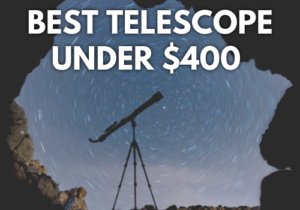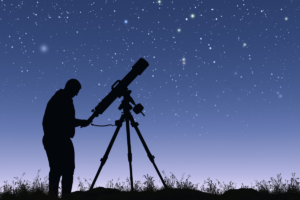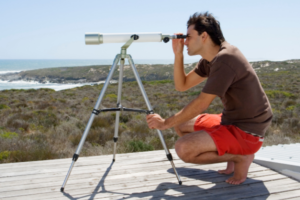7 Best Telescope Finder Scopes of 2026; Reviews
Disclosure: This post contains affiliate links and I may earn a small commission (at no extra cost to you) if you click through and make a purchase. Thanks in advance – I really appreciate it!
The best telescope finderscope for you is the one that provides a wide field of view to help you locate celestial objects before observing them through your main telescope.
A finderscope is one of the most important telescope accessories you can buy, and it comes in a variety of styles. But, whichever the style may be, a best telescope finder scope will help you locate and center objects more easily in the vastness of the night sky.
What is a Finderscope?
A finderscope is a small wide-field telescope mounted on a larger telescope that helps an observer quickly aim at terrestrial or celestial objects.
Because of their light-gathering capacity, finder scopes are especially useful for finding faint celestial objects that cannot be seen with the unaided eye using non-magnifying finders such as a Telrad or red dot finder.
Many telescopes come only with a non-magnifying finder, while others come with a simple low-cost, low-aperture finder scope that gives dim, inverted views that make it difficult to use.
Best Telescope Finder Scopes
Our Top 3 Picks
Best Telescope Finder Scopes - Reviews
1. Celestron 51635 StarPointer Pro Finderscope
- Designed by astronomers for astronomers, this premium finderscope allows you to precisely zero in on your target
- Projects a dual-circle reticle, not a red dot that can obscure your subject
- Larger 40mm optical window offers a wider field of view so you can acquire targets quickly and easily
- Brighter LED for easy visibility during the day
- Easy dovetail connection; no tools required
The StarPointer Pro finderscope stands out as a thoughtfully designed reflex sight aimed at making celestial object acquisition fast and intuitive.
Unlike traditional magnifying finders, it projects dual illuminated circles instead of a single red dot, helping you center targets without obscuring them — a real advantage when star hopping or trying to spot faint objects near brighter stars. The larger 40 mm viewing window also gives you a wide field of view, so you spend less time scanning and more time observing once aligned.
In practice, this finderscope is easy to mount and set up on most telescopes thanks to its quick dovetail or bracket system that requires no tools, and the adjustable brightness makes it usable even in twilight or light-polluted areas. Its lightweight build keeps your telescope balanced, and the intuitive dual-circle reticle is easier for many beginners to use than simple red dot systems.
However, it’s worth noting that while the Pro variant is a clear improvement over basic red-dot finders (and preferred by many amateurs), some experienced observers still favor alternative sights like Telrads or optical magnification finders for the greatest alignment precision.
That said, for most hobbyists looking for a reliable, quick-to-use accessory that makes aiming your telescope simpler and more enjoyable, the StarPointer Pro delivers solid performance and real value for casual and intermediate stargazing sessions.
2. Celestron StarPointer Finderscope
- FIND TARGETS WITH YOUR TELESCOPE QUICKLY AND ACCURATELY: The StarPointer red dot finderscope adds “point & look” functionality to any telescope.
- RIGHT-SIDE-UP VIEWS: Unlike some finderscopes, the StarPointer keeps the sky right-side up, matching what you see with your unaided eyes for easy and intuitive use.
- ADJUSTABLE RED DOT: Turn the knob to adjust the brightness of the red dot. Keep it dim to preserve your night vision or turn it up to find land-based objects during the day.
- COMPATIBLE WITH TELESCOPES AND MORE: StarPointer attaches to just about any telescope thanks to its small footprint. It even works great with astronomical binoculars and spotting scopes.
- START OBSERVING RIGHT AWAY: Includes the mounting base and a long-lasting CR2032 3V battery.
The StarPointer is a simple red-dot finderscope designed with ease of use in mind — it gives you a 1× (unity) magnification view with a single adjustable red dot reticle that stays aligned with your telescope’s optical axis, keeping the sky right-side up and left-right correct as you look through it.
That means you can scan the sky with both eyes open and intuitively place the red dot on a star or other object to quickly center it in your telescope’s eyepiece. This design helps you locate targets much faster than struggling with a tiny optical finderscope, especially if you’re new to stargazing.
Installation and alignment are straightforward: the StarPointer mounts easily to almost any telescope using standard dovetail or bracket holes, and the brightness of the red dot is adjustable so you can dial it down for dark skies or boost it for twilight use.
Many users find that this makes initial setup and object acquisition a breeze compared to stock plössl-style optical finders that often come with beginner telescopes. Unlike magnifying finders, it doesn’t actually magnify stars — instead, it acts like a guided laser pointer into the sky, which is perfect for rough alignment and quick star hopping.
That simplicity is both a strength and a limitation: while the red-dot approach is very quick and easy to use, it doesn’t offer any magnification or graduated reticles for precision aiming on very faint deep-sky objects.
If you’re doing casual observing or aligning a GoTo mount, the StarPointer gets the job done with minimal fuss — but serious astrophotographers or advanced observers often supplement it with a more detailed optical finderscope or larger reticle system for fine pointing.
Overall, as a basic and highly affordable accessory, it’s a reliable choice that makes finding objects significantly less frustrating for most telescope owners.
3. Telrad Reflex Sight
- The easiest way to aim a telescope. The view seen through the window of the Telrad is continuous with the sky around it, not magnified or upside down.
The Telrad is a zero-magnification reflex finder that projects three illuminated concentric rings (0.5°, 2°, and 4°) onto a clear viewing window so you can see the night sky as it appears with the rings superimposed.
This design keeps both eyes open and shows the true sky rather than a tiny magnified patch, making star-hopping and initial object location intuitive and fast once aligned with your telescope’s optical axis. Unlike simple red-dot finders, those concentric circles match common star charts, which many observers find helpful for accurately moving from one star to the next across a wide field.
Mounting and alignment are quite straightforward: the Telrad comes with a base that sticks or screws onto your tube, and once set up, it stays aligned even if removed and reattached later.
The large, open view means you’ll often find yourself locating bright stars or deep-sky targets without switching between multiple finder eyepieces, and many seasoned observers use it alongside or instead of traditional optical finders because it makes rough pointing simple and unambiguous—especially on larger Dobsonian telescopes or during manual star hopping sessions.
That said, it’s not without trade-offs: the Telrad’s size and weight can be bulky on smaller telescopes, and because it shows only what your naked eyes can see, it doesn’t help detect fainter stars or objects that require magnification. Some users also note that intense light pollution or dew can affect visibility unless you add shields or plan your setup carefully.
But for many amateurs who love hands-on observing and star charts, the Telrad’s intuitive ring-based sighting system is a classic, highly effective tool that simplifies finding objects without optical magnification.
4. SVBONY Red Dot Finderscope
- This red dot sight comes with an adjustable small red LED dot is projected onto a non-magnifying viewing window so you can aim the main telescope quickly and easily
- Thumbwheels allow positioning of the red dot horizontally and vertically for precise telescope alignment
- The star pointer brightness of the red dot is adjustable to suit your preference;it is bright enough to use during the day or night
- Simple and effective red dot sighting device makes aiming your telescope;suitable for Celestron 80EQ 80DX 90DX SE SLT OMNI series astronomical telescopes and so on
- Includes bracket that fits the dovetail mounting base on many telescopes
The SVBONY red dot finder is a simple reflex targeting accessory that projects an adjustable red LED dot onto a clear, non-magnifying viewing window so you can aim your telescope quickly and intuitively.
It’s very lightweight (about ~70 g) and mounts easily with a dovetail slide-in bracket that fits many popular scopes like Celestron 80EQ, 80DX, 90DX, SE, and SLT models, making setup fast even on smaller telescopes. The red dot brightness can be dialed up or down to suit conditions from dusk to dark skies, and horizontal/vertical adjustments help you align it accurately with your main scope during your first session.
In use, it behaves much like other red dot finders — you keep both eyes open, place the red dot on a star or other object, and then look through your telescope’s eyepiece to see it centered.
This makes object acquisition significantly faster compared to struggling with a small magnifying finderscope, especially for beginners still learning star fields. Its minimalist design means there are no magnification optics to focus, so there’s nothing to fiddle with in the dark beyond setting your red dot alignment once.
That simplicity, however, is also its main limitation: because it doesn’t magnify, it doesn’t help you pinpoint fainter deep-sky objects the way a powered optical finder could, and it requires that you’ve aligned it well to be truly effective.
Some users find it excellent for quick pointing and basic target acquisition on wide fields, while others eventually supplement it with a magnified finderscope for more precise star hopping — especially on telescopes with long focal lengths or for higher-power observing.
Overall, it’s an affordable, reliable, and easy-to-use red dot sight that makes finding objects less frustrating for beginners and casual observers.
5. Celestron 94224 Polar Telescope Finderscope
- Polar alignment reticle for both Northern and Southern Hemispheres
- Eyepiece focus adjustment to achieve sharp focus on reticle
The Celestron Polar Axis Finderscope is designed specifically to help you polar align equatorial mounts like Celestron’s CG-5, Advanced VX, and CGEM series by allowing you to visually center Polaris or the Celestial Pole through an etched reticle instead of guessing by eye.
It doesn’t behave like a typical magnifying finderscope that shows objects through the main telescope — instead, you look through this accessory at the night sky with star patterns etched into the reticle (including familiar constellations and Polaris), which helps you orient the mount’s polar axis more accurately before observing or imaging.
Installation is straightforward: the polar finderscope mounts into the polar axis port on the back of the equatorial mount and focuses via an adjustable eyepiece, so the etched reticle appears clear when you’re aligning.
Because the reticle includes identifiable star patterns, many experienced observers find it a useful visual aid when setting up in the field — especially on clear nights when matching the patterns boosts confidence in alignment. Unlike illuminated red-dot sights, this unit is non-illuminated and battery-free, which cuts down on complexity and weight.
However, the lack of illumination can be a double-edged sword: in darker or hazy skies, it can be harder to see the etched star map or Polaris without using additional light, and some users report that initial alignment and calibration of the polar scope itself can take a few sessions to master.
For those focused mainly on casual visual observing, using the mount’s built-in alignment routines or digital polar alignment tools might be enough, but for astrophotographers and precision seekers who want better rough alignment before fine adjustments, this polar finderscope remains a valuable and classic accessory.
6. Astromania Red Dot Finderscope
- Finder Deluxe features a large viewing window; four different aiming reticle patterns to choose from; five brightness levels of red or green light; the power of the finder will be turned off when you turn the knob to R or G
- Horizontal and vertical fine adjustment set screws allow precise alignment of the reflex sight with the telescope; includes dovetail finder bracket that fits most telescopes; requires CR 2032 lithium button cell battery is included
- Finder Deluxe is a non-magnifying reflex sight that makes aiming your telescope easier and more accurate than ever day or night; projects a small red or green LED reticle pattern onto viewing window so easily aim telescope at night or during day
- Non-magnified way help to aim telescope accurately; Depend on chosen LED color LED emits red or green aiming pattern onto viewing window after simple alignment procedure; once pattern is lined up with intended target object; view through telescope
- With ED sight mounted rest gun on support and aim at target 50-100 yards away; test shots should be in same condition for maximum accuracy adjustment; each click adjustment moves the point of impact by 1 MOA approximately 1" at 100 vbs and 0.5" at 50 yds
The Astromania Finder Deluxe is a non-magnifying reflex sight that projects a bright LED reticle onto a clear viewing window so you can aim your telescope quickly with both eyes open — no optical magnification, just a sight you line up with the target in the sky.
What sets this version apart from the simplest red-dot sights is its multiple reticle patterns (dot, circle, crosshairs, etc.) and selectable brightness levels in both red and green, allowing you to customize how the aiming point appears depending on light conditions. The extra brightness settings make it usable not only in full darkness but even during twilight or daytime setup.
Build quality tends to be robust for the price, with an all-metal housing and a dovetail base that fits standard Vixen/SKY-watcher accessory shoes, so it mounts solidly to most scopes and stays put once aligned.
Users report that, once you’ve done an initial alignment, the reticle stays accurate for subsequent sessions and speeds up locating objects versus struggling with a tiny optical finderscope. Some hobbyists on astronomy forums mention that aligning the sight requires an Allen wrench and that the brightness control can feel a bit coarse in the dark, but overall it works well as a budget reflex aiming aid.
However, as with all reflex sights, it doesn’t magnify the sky — so while it greatly improves initial pointing and star hopping for bright objects, it won’t help you pick out faint deep-sky objects before looking through your main telescope.
For many beginners and casual observers, though, this finderscope provides a simple, effective improvement over basic tube finders and makes setup less frustrating.
7. Svbony SV182 Finderscope
- Positive image optical viewfinder provides stargazers with a bright; clear image through the viewfinder for easy aiming anywhere in the sky
- 6x30 metal star finder; SV182 viewfinder with 6x magnification and 30mm diameter lens collects enough light to make telescope aiming easy and fun
- An achromatic 2-element lens design; SV182 viewfinder has fully multi-coated achromatic viewfinder optics to effectively eliminate aberrations and chromatic aberrations
- Easy to use; with metal viewfinder bracket; 2 plastic 90 degree angle adjustment screws and a fixed spring loaded push-pull screw; only 2 screws need to be adjusted to find the target quickly
- Internal mattebox design; the SV182 viewfinder scope is fully threaded internally to minimise reflections
The SVBONY-style 6×30 achromatic finderscope offers a true optical finderscope experience with 6× magnification and a 30 mm objective lens, giving you a wide field of view that makes initial object acquisition easier than with high-power eyepieces alone.
The achromatic lens design helps reduce color fringing and provides a reasonably clear image of brighter stars and celestial landmarks, which is especially helpful when star-hopping or roughly centering targets before moving to higher magnification in your main telescope. This combination of low-to-moderate magnification and wide field is a good balance for many beginner/intermediate users.
Mounting and alignment are typical of optical finderscopes — you adjust it in three axes to align the scope’s crosshair reticle with your main telescope’s optical axis, and the right-angle eyepiece format makes viewing more comfortable on many telescope builds.
The right-angle design also keeps the image orientation comfortable for most observers, though like most basic finders it doesn’t offer correct-image optics (i.e., the view may be reversed or flipped). For many users this isn’t a major issue at low magnification but is worth knowing if you’re transitioning from a straight, correct-image optical finderscope.
On the downside, while a 6×30 finderscope is a significant step up from non-magnifying red-dot sights for faint object acquisition, it still won’t pull in the very faintest deep-sky targets — and setup can take a few sessions to dial in accurately.
That said, for beginners and casual observers looking for a traditional optical finderscope that helps bridge the gap between naked-eye aiming and main-telescope viewing, this model delivers good performance and value at a modest price point.

How to Use a Telescope Finder Scope
Using a telescope finder scope is pretty straightforward. Make sure that you align the finderscope with your telescope during the day.
First of all, pull out the clear plastic sheet that is at the front and on the bottom. This allows the battery to make contact so that the red dot appears when you switch it on.
Next, try the finder by switching it on. Look through the hole at the front of the finder and you should see the red dot or reticle and be able to make it brighter or dimmer by using a switch or a knob on the finderscope.
Now set your scope up as normal but put the red dot finder on instead of the usual optical finder.
Point your telescope to something like a TV aerial or a chimney – anything about that size will do, and the further away the better.
Looking through a low-power eyepiece (25mm is ideal) find the object by adjusting your telescope and focusing the object.
Adjust the mount using the slow-motion controls so that the object is right in the center of the view.
Adjust the finder so that the red dot or reticle is exactly on the object you were looking at.
Switch it off and wait until dark.
You now use it by switching the finder on, then looking through the finder so that the red dot lines up to the target you are going to observe through your telescope.
Once the red dot is exactly over the star or planet it should be exactly in the center of your eyepiece view.
Remember to switch off your finderscope once you have found your target to save the battery.
Types of Telescope Finderscopes
The finderscopes mainly come in three different designs.
1. Red Dot Finder
The Red Dot Finderscopes are simple and easy-to-use and they generally come with zero magnification view of the sky that is right-side up and left-to-right correct.
Some red dot finders project shapes other than a red dot, like a bull’s eye or a crosshair. Other models let you choose from a collection of illuminated reticles or dots.
2. Right Angle Finder
A right-angle finder scope has an eyepiece that faces up. This makes it easier to look through, especially when the telescope is pointing high overhead. Many right-angle finder scopes are “image erect” or “image correct” as well, which means the image you see will be right side up and/or left-to-right correct.
So if you wish to avoid a stiff neck and painful contortions when looking through a straight-through finder, a right-angle finder scope is the solution.
These scopes use a small prism diagonal to direct the light upward into the eyepiece at a right angle to the finder tube.
Right-angle finders can be used with most telescopes, but they tend to be especially easy to use with Newtonian reflectors when they are placed in proximity to the telescope’s focuser.
3. Straight-Through Finderscopes
A straight-through finder puts the eyepiece at the back facing out. These finderscopes look like miniature telescopes. You look straight through the eyepiece and down the optical axis to achieve magnification. Straight-through models are best for refractors or Schmidt-Cassegrain telescopes.
Conclusion
I hope this article has helped you sort out and compare different models to pick out the best telescope finderscope for yourself. These devices work by showing more of the night sky than your telescope does, but they work by centering on exactly the same piece of sky. With the information in this guide, you will be ready to make the right choice for your telescope and observing interests.
Written by:

Prakash Chandra
I am a science and technology enthusiast who is curious about emerging concepts in spaceflight, aerospace, and robotics. My passion for astronomy started in my childhood, and my craze for writing started when my works got published in my school's newspaper.
ABOUT US
We are a team of active amateur astronomers, here to help you with all your astronomy and science related needs – this is anything, from reviewing the latest telescopes to be released to talking about gravity and neurons. The Big Bang Optics was started because of our love for astronomy and to help others like us find the best telescope and accessories.
LEGAL DISCLAIMER
The Big Bang Optics is a participant in the Amazon Services LLC Associates Program, an affiliate advertising program designed to provide a means for sites to earn advertising fees by advertising and linking to Amazon.com. The Big Bang Optics also participates in affiliate programs with Clickbank and other sites. The Big Bang Optics is compensated for referring traffic and business to these companies.











